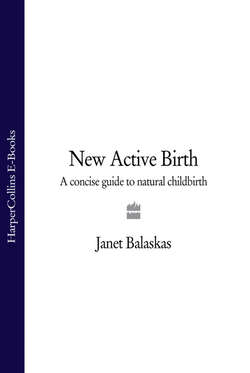Читать книгу New Active Birth: A Concise Guide to Natural Childbirth - Janet Balaskas - Страница 27
How does yoga work?
ОглавлениеPractically speaking, yoga provides a system of exercises to help you recover the natural range of movements your body is designed to make, in harmony with the force of gravity, and to maintain structural fitness (see Recommended Reading).
In our modern technological society, most of us are victims of a hidden epidemic of muscular stiffness which inhibits our potential for movement at the joints and throws our posture off balance to a greater or lesser degree, so that our bodies are fighting gravity rather than existing in harmony with it. This results in any combination of structural imbalances such as tight shoulders, protruding head and neck, exaggerated spinal curves, rigid pelvis, stiff legs, etc., and the inevitable headaches, backaches, and other aches and pains which accompany them.
This state of affairs is brought about by the stresses and strains of modern life, sedentary life styles, loss of contact with nature, poor postural habits and physical education, and the suppression of emotions which are commonplace in our society. Most of us, without ever being aware of it, end up carrying a load of unnecessary tension around with us, actually bound up in our muscles and joints. Without our knowing it, this limits our physical and mental potential and separates us from our instinctive selves. Yoga gets to the root of tension in the body and gives us an opportunity to breathe, let go and release it. It is a fundamental approach to relaxation which has tremendous transformative potential and power at any time, but it is particularly appropriate in pregnancy.
While some yoga positions involve a complex combination of movements which affect different parts of the body simultaneously, a simple forward bend will help us to understand how the underlying mechanical principle of yoga-based exercise works.
A forward bend is a positional exercise to encourage passive relaxation of the hamstring muscles at the back of the legs, while the body is positioned to allow maximal movement of the hip joints in relation to gravity.
TRY THIS:
Stand upright with your feet about 12 inches apart and parallel. Allow your weight to settle down into your heels as you exhale, until you feel your feet are well grounded. Now, without bending your knees, bend forward slowly from your hips keeping your spine straight.
Hold for a few seconds, breathing deeply, and then come up slowly.
You no doubt felt a stretching sensation in the muscles at the back of your legs as the movement caused them to lengthen and relax. You are probably wondering why this was painful, if the muscles were relaxing. The reason is that it is so long since you have made the full movement that the hamstring muscles at the back of your legs have shortened and lost their elasticity, restricting your ability to move forward.
Nature has designed your body to be able to fold over like a jack-knife, with your stomach and chest flat against your thighs and the palms of your hands on the ground in front of you. Of course, during the later months of pregnancy, this can only be done with legs apart to make room for your belly! (See here) In this position your feet are firmly grounded and gravity draws your trunk forward with a hingelike movement from the hips. Your spine should be completely passive and relaxed while the front of your body contracts and the hamstring muscles lengthen and extend.
Breathing deeply while in the position allows you to release the tightness you feel until eventually you can make the movement with greater ease.
You will probably find, as you experiment with other movements, that this state of chronic tension exists throughout your body to some degree, affecting some areas more than others. The most effective way to become more relaxed and supple is by beginning to make the neglected movements we were designed by nature to make. It is simply a matter of spending some time each day practising them. Gradually stiff muscles will lengthen and regain their elasticity, and joints will become more mobile as tension is released.
The programme of yoga-based exercises that follows will cultivate relaxation and flexibility in a safe, passive and non-strenuous way, which harnesses the help of the forces of gravity and your natural potential for movement. Pregnancy is a unique and marvellous time to let go of habitual tensions and to allow your body to become more open and relaxed.
‘I’d never exercised before and found some of the positions quite hard to start with but gradually, with practice, I loosened up. I concentrated mainly on about six or seven exercises which I tried to do every day.’
